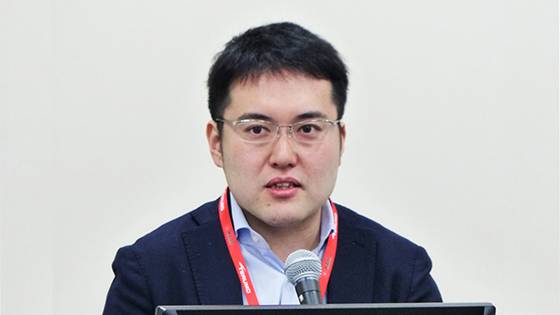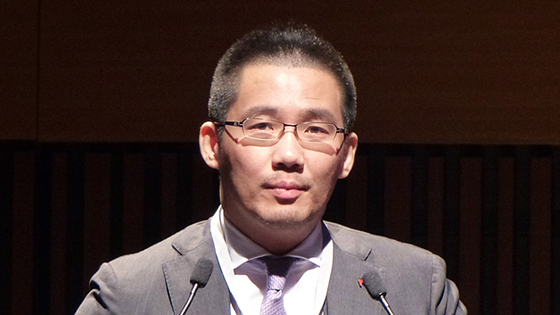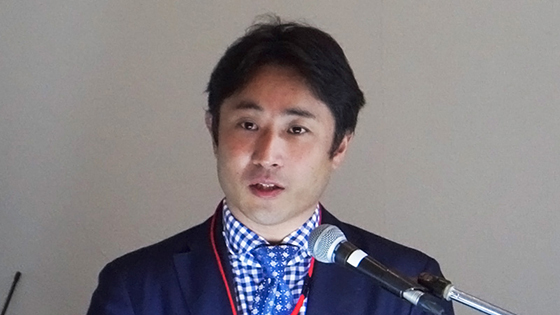Please tell us about the background of this study.

Dr. Watanabe: About 20%-30% of patients who undergo TAVI also have AF, so there are many patients who require anticoagulation after TAVI. However, patients who undergo TAVI tend to be elderly, female, small in size, and have a high bleeding risk (HBR).
Before the revision, the 2013 Guideline on Pharmacotherapy of Cardiac Arrhythmias stated that warfarin was recommended for all patients with AF after aortic valve replacement (AVR), but it was found that there were many patients who were difficult to treat with warfarin due to bleeding.
Although we, as clinicians, felt that the use of direct-acting oral anticoagulants (DOACs) after TAVI could solve the problem of warfarin, it was difficult to use them in actual clinical practice due to the lack of data and the fact that they were not mentioned in the guidelines. At the same time, there was a movement in Europe and the United States to conduct a randomized study of DOAC and warfarin for AF patients after TAVI, and after Dr. Shigeru Saito of Shonan Kamakura General Hospital and Dr. Kentaro Hayashida talked to us about it, we decided to participate in this ENVISAGE-TAVI AF trial.
In a trial conducted by our OCEAN group, the group of patients who were prescribed DOAC showed a significantly better effect on hard events including all-cause mortality than the warfarin group.1 This clinical trial has since attracted worldwide attention and I was recently interviewed by Reuters as one of its authors.

Dr. Hayashida: The ENVISAGE-TAVI AF trial was also sponsored by Daichi Sankyo, and I am very grateful that the OCEAN-SHD group was invited to participate in this global event as a representative of Japan. Dr. Shigeru Saito was the head of the Japanese team and I was the leader, but the OCEAN-SHD team were the ones who physically carried the trial out.
Actually, the one who had contributed to the study the most was Dr. Watanabe, who was in charge. Since this trial was an RCT, it fell under the category of specific clinical research as outlined by the Japanese Clinical Trials Act (CTA), which meant the doctors would be held responsible for any events that occurred. I can safely say that this trial required more care and attention than any before.

Dr. Yamamoto: It was easy for us to conduct this at our hospital because the director, Dr. Takahiko Suzuki, understood its importance. As a result, the Heart Center Group became the top enroller in Japan. As Dr. Hayashida already mentioned, it was not an easy trial because it fell into the category of specific clinical research meaning there were many restrictions which certainly took its toll.
Since there had never been a study comparing DOAC and warfarin in TAVI valves, this global trial was conducted under a very strict supervision. A subanalysis of the previous ENGAGE AF-TIMI 48 trial showed that DOACs were effective in surgical bioprostheses, but there was a lack of evidence for TAVI valves. The ENVISAGE-TAVI AF trial was the first to prove this.
What is the standard regimen of antithrombotic therapy for AF patients after TAVI in your daily clinical practice?
Dr. Watanabe: In my clinical practice, I felt that DOACs were more effective and safer than warfarin, so I had no concerns about using DOACs for AF patients after TAVI. But since there hadn’t been any data yet, we needed clear evidence that DOACs were good for AF after TAVI.
Dr. Hayashida: Previously, DOACs were said to be off-label for valvular AF, so there was a gray zone regarding its use after TAVI, but we knew they were safer and more effective than warfarin. Dr. Watanabe and his colleagues showed that DOACs were more effective in suppressing hard events than warfarin, and at the same time, the guidelines were being revised, so after that we were ready to use DOACs for AF patients after TAVI more confidently.
Dr. Yamamoto: The wording of the guideline was not clear, and it didn’t state that DOACs were contraindicated for use. This is where the gray zone came in, but in the 2020 revision of the guidelines, the term "mechanical valve" was clearly stated, so it is now possible to interpret other indications as indications for DOACs, making it easier to use them in actual clinical practice.
The average age of the patients was 82 years old, and about half of them were women. Were the backgrounds similar for the Japanese patients?
Dr. Hayashida: Since the guideline was revised in 2020, the average age of the patients has steadily decreased. And now, as the number of younger patients increases, this trial will prove to be an important step forward in examining how safe and effective DOAC is when considering their long-term use.
The data from the OCEAN-TAVI registry presented by Dr. Watanabe and Dr. Hideyuki Kawashima (Teikyo University) showed that the mortality rate was lower in the DOAC group. On the other hand, the ENVISAGE-TAVI AF trial showed non-inferiority at the primary endpoint, but not superiority. We believe this is because Japanese patients may be more predisposed to bleeding complications, and that the difference in average age may have also influenced the results.
The rate of severe bleeding was higher in the edoxaban group. Were the results similar for the Japanese patients?
Dr. Watanabe: In the ENVISAGE-TAVI AF study, gastrointestinal bleeding was observed in 56 patients in the edoxaban group and 27 patients in the warfarin group, with a hazard ratio of 2.03. This is high despite the similar use of proton pump inhibitors. We will have to wait for the results of the sub-study to see if this is a tendency among Japanese patients.
Dr. Yamamoto: When comparing DOACs and warfarin in bleeding-related deaths, DOACs have been shown to be effective in the past, but the fact that there was no difference in all-cause mortality despite the bleeding events being higher in the DOAC group this time suggests that the bleeding caused by edoxaban may not have been fatal. In past clinical studies, the increase in bleeding-related deaths was linked to the outcome, but the results of the ENVISAGE-TAVI AF trial suggest something different.
This time the DOAC used was edoxaban. Would we get similar results with other DOACs?
Dr. Watanabe: According to the OCEAN data, 70% of patients used apixaban, followed by rivaroxaban, edoxaban, and finally dabigatran. There is no indication of which is superior in terms of effectiveness, and this data is thought to be due to the historical background, since edoxaban was the most recently approved.
Dr. Yamamoto: The data that Dr. Watanabe mentioned is a little outdated, but there was a paper that showed that apixaban reduced the risk of bleeding so that may have been used more often. I think the exact drug used is unlikely to be limited by any bias.
What percentage of patients who undergo TAVI in clinical practice have AF?
Dr. Watanabe: I don't have the exact number, but at our hospital around 20-30% of TAVI patients have AF.
Dr. Hayashida: At our hospital, the percentage of patients undergoing TAVI for aortic stenosis who also have AF is about 20-30%. Until now, we had to use warfarin, and we were very nervous about the risk of bleeding. However, recently, the use of DOAC has been approved and we can now manage TAVI-AF patients with peace of mind. Now that we have published the results of the ENVISAGE-TAVI AF trial, we can happily prescribe DOACs and discharge our patients accordingly.
Dr. Yamamoto: At our hospital, the percentage of patients who undergo TAVI with AF is about 20%, and although we had been using DOACs for patients who we determined needed them, after the results of this trial we can now use them with the same confidence as Dr. Hayashida.
- Kawashima H, et al. JACC Cardiovasc Interv. 2020; 13: 2587-2597








